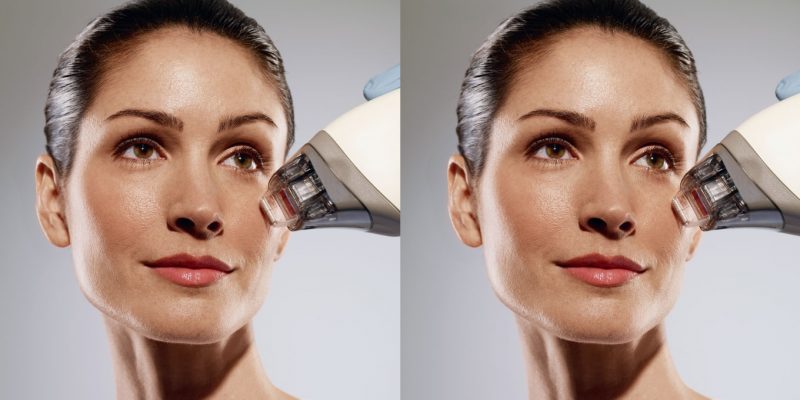Health & Fitness
Psoriasis Warrior Brings the Power of Positive Thoughts and Open Conversations
After hiding under her clothes for years, Reena Ruparelia took charge of her life by no longer letting her psoriasis control her.
by : ELLECanada.com- Oct 26th, 2023
It took 20 years before Reena Ruparelia was able to share her story about living with psoriasis. After being diagnosed at the age of 14, she spent years hiding her condition from the world.
What started as a rash on her stomach soon spread to her legs, arms, torso and back. “I remember when I was first diagnosed, I just wanted it to be gone. I felt really vulnerable and helpless, and I was confused about what it meant to have a lifelong chronic condition that had treatments but no cure.”
What Ruparelia did not know at the time is that she was not alone. According to the Canadian Dermatology Association, approximately one million Canadians live with psoriasis. The most common is plaque psoriasis, which affects 90 percent of patients. It appears as raised, scaly red or purplish patches that can form anywhere on the body. Between 21 and 30 percent of people with psoriasis develop intertriginous (or inverse) psoriasis, which affects the folds of the skin, including genital areas.
In Ruparelia’s efforts to be accepted, she hid under her clothes. “I pretended to be okay and kept waiting for that magical day when it would disappear.”
Beyond the condition itself, like many patients with psoriasis, she felt isolated and alone in her struggles. At the age of 35, she hit a breaking point. “I had a panic attack at work when I was having a flare-up and couldn’t grip my mouse without splitting the skin on my hand. I realized at that moment I had to do something.”

The road to becoming a Psoriasis Warrior
Ruparelia took a leave of absence from work. The time allowed her to own her condition rather than letting it control her. She drew upon her skills in training and mindfulness to become a self-proclaimed “Psoriasis Warrior” and, through social media, dedicated herself to supporting others.
“I thought, ‘What if I started to challenge things about myself? What if I could bring my skin journey to others without judgment? What if I was worthy enough to go to a dermatologist to seek treatment and do something holistically to support my mental, emotional and physical health?’”
There were two things, however, that made her nervous about moving forward, she says. “One was having a candid conversation with a doctor, and the other was my frustration with using treatments that didn’t work.”
She quickly discovered that there was nothing to fear after finding a dermatologist who helped her feel comfortable enough to engage in an open dialogue. “One of the first things she said was ‘You don’t have to live like this. There are options for you.’ That offered me hope and a level of comfort I had never experienced before.”
Overcoming embarrassment to be more in control
“Patients feel uncomfortable talking about rashes, particularly in sensitive areas such as the genitals,” says Dr. Geeta Yadav, founder of FACET Dermatology in Toronto.
According to a March 2023 Leger study, 43 percent of people living with intertriginous psoriasis say they are embarrassed to show the affected areas to a physician, making it difficult to diagnose and treat.
“If patients aren’t comfortable talking about psoriasis in areas that are generally hidden, it’s harder to make a diagnosis or find a treatment that’s the right fit. In the meantime, they are experiencing a lot of issues within their personal and professional lives that they don’t need to.”
When it comes to available psoriasis options, physicians often start with topical corticosteroids (and sometimes non-steroidal topicals, including more recent topicals known as PDE4 inhibitors), before trying phototherapy, oral therapies and/or injections. Often, patients require different topicals for different locations on their skin, leading to complex regimens that can affect treatment adherence.
“While steroidal topicals are the most commonly used first line of treatment, many patients or their caregivers express concerns,” says Yadav. “‘Is it a steroid?’ is a question I get all the time when I suggest topical treatments. People are worried about side effects and long-term use. They want topicals that are effective, safe and easy to use. It often used to take two to three types of topical treatments to manage psoriasis—for example, elbow psoriasis is not like psoriasis on the face.”
There has been considerable research and development into treatments for psoriasis. Recent innovations have brought new non-steroidal agents to market. “We’re seeing new additions that respond to patients’ needs—single steroid-free topicals that could be used on multiple areas of the body,” says Yadav. “We’re treating psoriasis with better skin clearance and making life easier for patients.”
Over and above the treatment options, communication is a critical part of the healing process. “If you have a person you can trust, you will be more willing to be open about your condition,” says Yadav. “It all starts with trust.”
That’s something that Ruparelia stresses to her growing league of followers. “I tell them they don’t need to be ashamed in front of doctors. There are treatments to support us. So, the more you share and track your symptoms, the better they can help with treatment options—and the sooner you can live the life you want.”
For more information about the survey and psoriasis, visit canadianpsoriasis.ca.
Sponsored by Arcutis Canada Inc.
Photo credit: Shannon Laliberte (forest)
Newsletter
Join our mailing list for the latest and biggest in fashion trends, beauty, culture and celebrity.
Read Next

Culture
Introducing 2024’s Most Innovative Products, Voted on By Canadians
*Adds to cart*
by : ELLE Canada- May 1st, 2024

Fashion
5 Summer Wedding Guest Outfits We’re In Love With
From country western cool to beachy barefoot elegance, you'll be dressed to the nines all season long.
by : Alison McGill- May 1st, 2024

Fashion
8 Sparkling Jewellery Gifts to Give This Mother’s Day
Show your gratitude with pieces they’ll have forever and ever.
by : ELLE Canada- Apr 29th, 2024






